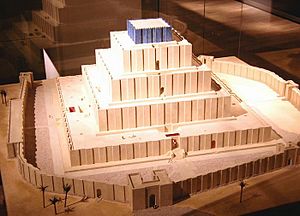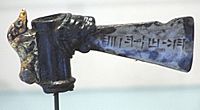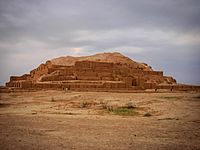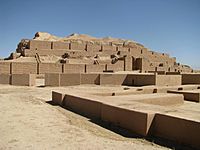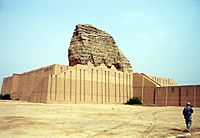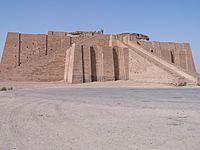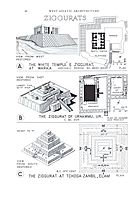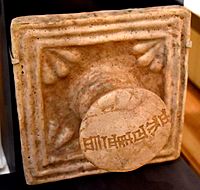Chogha Zanbil facts for kids
|
چغازنبيل (Persian)
Dur Untash (Elamite) |
|
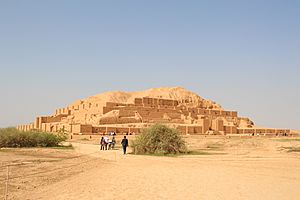
Ziggurat at Chogha Zanbil
|
|
| Location | Khuzestan Province, Iran |
|---|---|
| Coordinates | 32°0′30″N 48°31′15″E / 32.00833°N 48.52083°E |
| Type | Settlement |
| History | |
| Builder | Untash-Napirisha |
| Founded | 1250 BC |
| Abandoned | 640 BC |
| Cultures | Elamite |
| Site notes | |
| Excavation dates | 1951–1961 |
| Archaeologists | Roman Ghirshman |
| Condition | In ruins |
| UNESCO World Heritage Site | |
| Official name | Tchogha Zanbil |
| Criteria | Cultural: (iii), (iv) |
| Inscription | 1979 (3rd Session) |
Chogha Zanbil is an ancient complex built by the Elamite people in Iran. It is located in the Khuzestan province. This amazing place is one of the very few ziggurats (which are huge stepped towers) found outside of Mesopotamia. It sits about 30 kilometers (19 miles) southeast of Susa.
Contents
What is Chogha Zanbil?
The name Chogha Zanbil means 'basket mound'. It was built around 1250 BC by a king named Untash-Napirisha. He mainly built it to honor a very important god called Inshushinak. The original name for this place was Dur Untash, meaning 'town of Untash'. However, it's thought that not many people actually lived there, mostly just priests and servants.
The entire complex is protected by three big, circular walls. These walls divide the 'town' into different areas.
Inside the Walls
- The inner area has a huge ziggurat. This ziggurat was built for the main god, Inshushinak. It was built on top of an older temple that also had storage rooms.
- The middle area holds eleven temples for other, less important gods. It's believed that the king planned to build twenty-two temples in total. But he died before they could be finished, and the kings after him didn't continue the work.
- The outer area contains royal palaces. There's also a special palace for funerals, which has five underground tombs for royalty.
Even though building stopped after King Untash-Napirisha died, people continued to live at Chogha Zanbil. The site was finally destroyed in 640 BC by the Assyrian king Ashurbanipal. Some experts think that King Untash-Napirisha wanted to make Chogha Zanbil a new main religious center. He might have wanted it to replace Susa and bring together the gods from different parts of Elam.
The Ziggurat's Size and Materials
The ziggurat was originally very large. Each side measured about 105 meters (345 feet), and it was about 53 meters (174 feet) tall. It had five levels and a temple at the very top. The main material used to build everything was mud brick. The ziggurat itself was covered with baked bricks. Many of these bricks have special writings called cuneiform characters on them. These writings show the names of gods in the Elamite and Akkadian languages.
Today, the ziggurat is only about 24.75 meters (81 feet) tall. This is less than half of its original height. However, it is still very well preserved. Because of its excellent condition, UNESCO considers it the best example of a stepped pyramid monument. In 1979, Chogha Zanbil became the first place in Iran to be added to the UNESCO World Heritage List.
Discovering Chogha Zanbil
Chogha Zanbil was discovered and studied by an archaeologist named Roman Ghirshman. He led excavations (digging up ancient sites) over six seasons, from 1951 to 1961.
Threats to the Site
Today, Chogha Zanbil faces a threat from oil exploration. Because there's a high demand for oil around the world, companies are doing seismic tests to find oil reserves nearby. Some oil digging has happened as close as 300 meters (984 feet) away from the ziggurat. This activity could potentially harm the ancient foundations of the site.
Gallery
See also
 In Spanish: Choga Zanbil para niños
In Spanish: Choga Zanbil para niños
- Step pyramid
- Iranian architecture
- List of Iranian castles, citadels, and fortifications
- Cities of the ancient Near East




